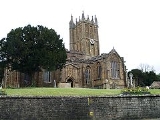
Church of St Mary, Ilminster
Encyclopedia
The Church of St Mary in Ilminster
, Somerset
, England dates from the 15th century and has been designated as a Grade I listed building.
Ilminster takes its name from the River Isle
and its large church of St Mary, which is known as The Minster. The 15th century Hamstone
building was refurbished in 1825 by William Burgess and the chancel restored
in 1883. Further restoration took place in 1887-89 and 1902.
Among the principal features are the Wadham tombs; those of Sir William Wadham and his mother, dated 1452 and Nicholas
and Dorothy Wadham
1609 and 1618.
The tower, which was built in the first quarter of the 16th century, rises two storeys above the nave. It has three bays, with a stair turret to the north-west corner. The bays are articulated by slender buttresses with crocket
ed finials above the castellated parapet. Each bay on both stages contains a tall two-light mullioned-and-transomed window with tracery. The lights to the top are filled with pierced stonework; those to the base are solid. The stair turret has string courses coinciding with those on the tower, and a spirelet with a weathervane. It contains a bell dating from 1732 made by Thomas Bilbie and another from 1790 made by William Biblie of the Bilbie family
.
Ilminster
Ilminster is a country town and civil parish in the countryside of south west Somerset, England, with a population of 4,781. Bypassed a few years ago, the town now lies just east of the intersection of the A303 and the A358...
, Somerset
Somerset
The ceremonial and non-metropolitan county of Somerset in South West England borders Bristol and Gloucestershire to the north, Wiltshire to the east, Dorset to the south-east, and Devon to the south-west. It is partly bounded to the north and west by the Bristol Channel and the estuary of the...
, England dates from the 15th century and has been designated as a Grade I listed building.
Ilminster takes its name from the River Isle
River Isle
The River Isle flows from its source near Combe St Nicholas, through Somerset, England and discharges into the River Parrett south of Langport near Midelney....
and its large church of St Mary, which is known as The Minster. The 15th century Hamstone
Hamstone
Hamstone is the colloquial name given to stone from Ham Hill, Somerset, England. Hamstone is a Jurassic limestone from the Toarcian, or Upper Lias, stage. It is a well cemented medium to coarse grained limestone characterised by its honey-gold colour and marked bedding planes. The stone contains...
building was refurbished in 1825 by William Burgess and the chancel restored
Victorian restoration
Victorian restoration is the term commonly used to refer to the widespread and extensive refurbishment and rebuilding of Church of England churches and cathedrals that took place in England and Wales during the 19th-century reign of Queen Victoria...
in 1883. Further restoration took place in 1887-89 and 1902.
Among the principal features are the Wadham tombs; those of Sir William Wadham and his mother, dated 1452 and Nicholas
Nicholas Wadham
Nicholas Wadham was the benefactor of Wadham College, Oxford.-Life:Wadham was probably born at Merrifield, near Ilton, Somerset. He was the only son of John Wadham and his wife, Joan, daughter of John Tregarthin and widow of John Kellaway. A biography written before 1637 notes Wadham as attending...
and Dorothy Wadham
Dorothy Wadham
Dorothy Wadham was the wife of Nicholas Wadham and, as his widow, the founder of Wadham College, Oxford.Wadham was the second and eldest surviving child of Sir William Petre, a civil and canon lawyer serving King Henry VIII, and his wife, Gertrude, daughter of Sir John Tyrrell. Her portrait in...
1609 and 1618.
The tower, which was built in the first quarter of the 16th century, rises two storeys above the nave. It has three bays, with a stair turret to the north-west corner. The bays are articulated by slender buttresses with crocket
Crocket
A crocket is a hook-shaped decorative element common in Gothic architecture. It is in the form of a stylised carving of curled leaves, buds or flowers which is used at regular intervals to decorate the sloping edges of spires, finials, pinnacles, and wimpergs....
ed finials above the castellated parapet. Each bay on both stages contains a tall two-light mullioned-and-transomed window with tracery. The lights to the top are filled with pierced stonework; those to the base are solid. The stair turret has string courses coinciding with those on the tower, and a spirelet with a weathervane. It contains a bell dating from 1732 made by Thomas Bilbie and another from 1790 made by William Biblie of the Bilbie family
Bilbie family
The Bilbie family were bell founders and clockmakers based initially in Chew Stoke, Somerset and later at Cullompton, Devon in south-west England from the late 17th century to the early 19th century....
.

